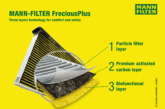
Ian Jackson, Digital Solutions / Technical Systems Manager at Continental Tyres, discusses tyre pressure monitoring.
What are the benefits of correct tyre inflation / tyre pressure monitoring systems for truck operators?
Ian Jackson (IJ): Underinflation of tyres significantly affects rolling resistance, increasing both fuel consumption and carbon emissions, as well as intensifying tyre wear and even reducing a tyre’s service life – all of which adversely affect operating costs.
The use of tyre pressure monitoring systems (TPMS), such as ContiConnect Solutions, minimises these issues, by ensuring that each tyre is operating at the correct pressure and temperature. Such systems work best when a sensor is placed within the tyre itself, transmitting visible and audible warnings to a display in the cab, and alerting drivers to potential problems. ContiConnect Solutions can also alert office-based fleet support staff to any problems which occur. Warnings provided from such accurate TPMS systems not only help avoid dangerous tyre blowouts, but also help prevent costly vehicle downtime, keeping the trucks on the road.
But safety warning is only one benefit of a TPMS system. Tyres are directly responsible for 5% of the total operating costs but have an influence over a huge 40% of overall costs because of the effect tyre rolling resistance has on fuel use, and subsequent maintenance costs. Simply put, tyres which are operating at the correct pressure, maximise fleet efficiency and save money. What is more, the added advantage of tyres which run efficiently is that fuel consumption is lowered, and tyre wear is reduced – both of which ensure CO2 emissions are cut, to help protect the environment.
The ContiConnect Solutions technology has been successfully integrated within many of our fleet customers operations for many years from the more traditional road trunking operation to arduous tipper applications and has proven itself to be one of the most robust and reliable TPMS systems on the market.
![]()
Which tyre pressure monitoring solutions are available and how should operators choose what is best for their fleet?
IJ: Continental have a wide suite of ContiConnect digital solutions available, and we work closely with each operator to ensure the right system is in place to meet their particular requirements.
Each solution starts with ContiConnect tyre pressure sensors, which are mounted onto the tyre’s inner liner. These sensors transmit real-time tyre pressure and temperature data, and depending on the system chosen, this data can be sent directly to a display in the driver’s cab, can be captured as vehicles return to base by the Yard solution or if a fleet needs remote tyre pressure monitoring, the sensors also connect to ContiConnect Live – a central web portal accessed by fleet managers.
ContiConnect Live is able to monitor the tyre pressure of multiple vehicles, regardless of their location, while they are on the road, whereas ContiConnect Yard, measures tyre pressure on multiple vehicles which regularly enter a yard, noting the date and time as the vehicle passes a dedicated fixed check-point, and reporting the status of each tyre to the web portal.
Tyre data can also be captured with Continental’s hand-held tool, which allows drivers or fleet managers to manually upload information and share to the ContiConnect web portal. This entry level manual solution is useful where live tracking is not required, for vehicles which do not frequently return to a dedicated checkpoint, or for instances when vehicles are not in range of ContiConnect Yard. The hand-held tool provides a quick and easy alternative to using a gauge to measure tyre pressure. Users simply scan the sensor from the side of the tyre, without any need to remove valve caps, measure, read pressure and replace the cap.
ContiConnect is completely scalable depending on requirement, and we work closely with customers to understand how they wish to monitor tyre pressure, in order to provide the best solution to meet this need. Tyre sensor notifications are also customisable depending on which data a fleet manager needs to see, and how frequently, if not in real time. The system can also manage data from multiple vehicles, to help fleet managers who may wish to switch from less flexible manual service planning, to a more targeted proactive maintenance plan. Such predictive tyre management helps fleets reduce costs associated with unplanned tyre maintenance and replacements and helps safeguard the fleet’s safety.
![]()
How do tyre pressure monitoring solutions work with trailer tyres?
IJ: In recent years there has been a steady increase in the popularity of TPMS systems on tractor-unit tyres, as fleet operators begin to understand the increased efficiency they bring, but traditionally accessing this data on trailer tyres has proven to be trickier, although no-less important.
Continental are the first to offer a standalone TPMS system for trailers. The newly launched system is the first of its kind available in the UK and is designed to work both as a standalone trailer tyre monitoring package, or fully integrated into an existing truck TPMS system. This was proven during a joint initiative with Mercedes-Benz Trucks UK, which resulted in the system now being embedded into the Truck App portal on the new Actros.
The technology shows the tyre pressures of the trailer tyres in real time on a display mounted on the bulkhead. The driver is also warned of any issues while driving via an LED warning light system, which is visible via the driver mirrors.
Plus Continental also offer their own driver app for Android phones which provides constant real time tyre pressure and temperature information to the driver via a dongle integrated within the trailer system.
The Continental-designed system is highly adaptable, and can be used with any trailer configuration, including multideck trailers, giving even better visibility of trailer tyre pressures to drivers and fleet managers.
What is the future for tyre efficiency – will tyre pressure monitoring help?
IJ: Continental continues to innovate to provide customers with the tyre pressure monitoring they need to really drive efficiency. Today’s tyres include pressure and temperature sensors, but the tyres of tomorrow will be even more ‘intelligent’, with technology to monitor tread depth and tyre age data, for example.
The truth remains that even a tyre with the latest in cutting-edge technology will not perform to its full potential if inflation pressure is not maintained correctly. Accurate measurement and maintenance of tyre pressure, via intelligent systems such as ContiConnect Solutions will always hold the key to efficient, sustainable and safe fleet operations.








